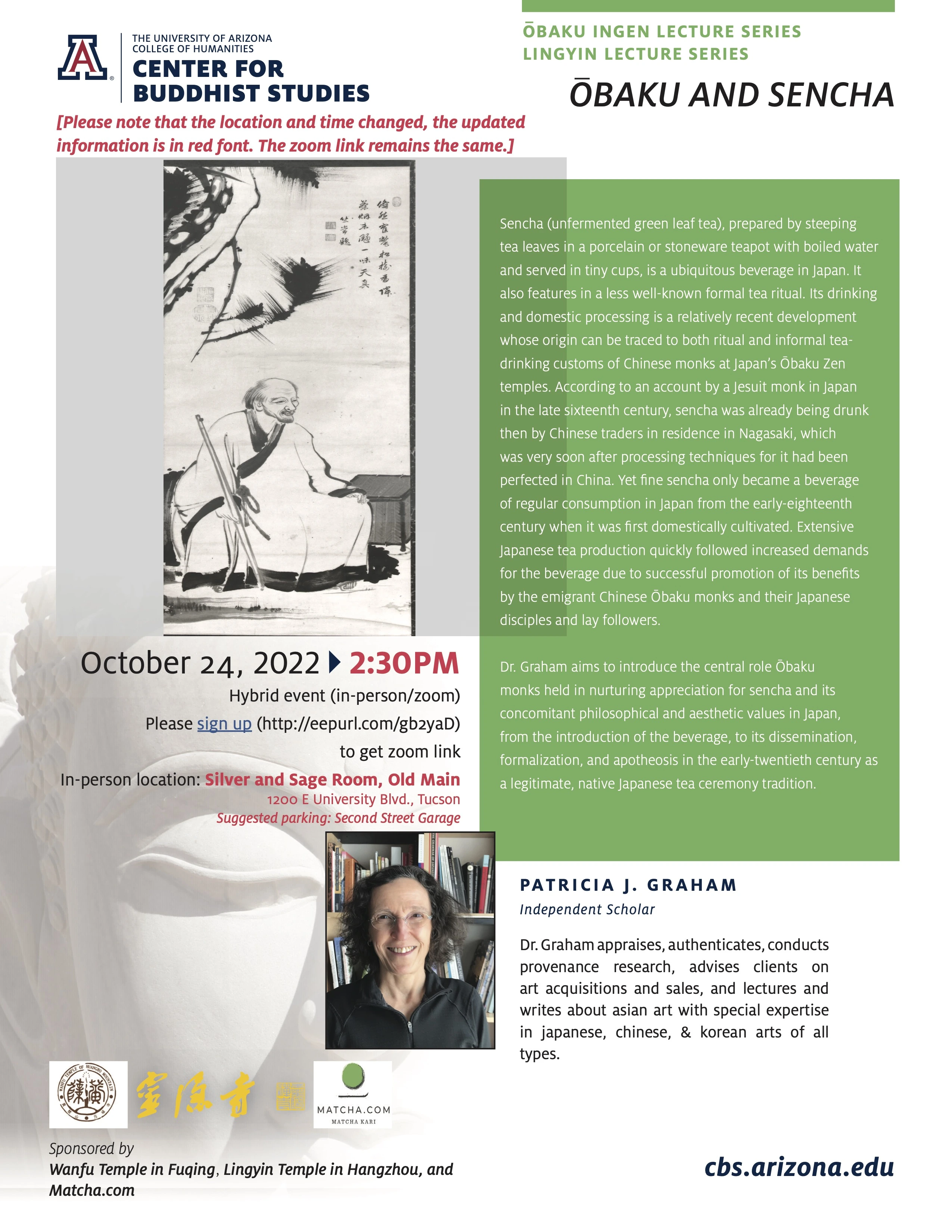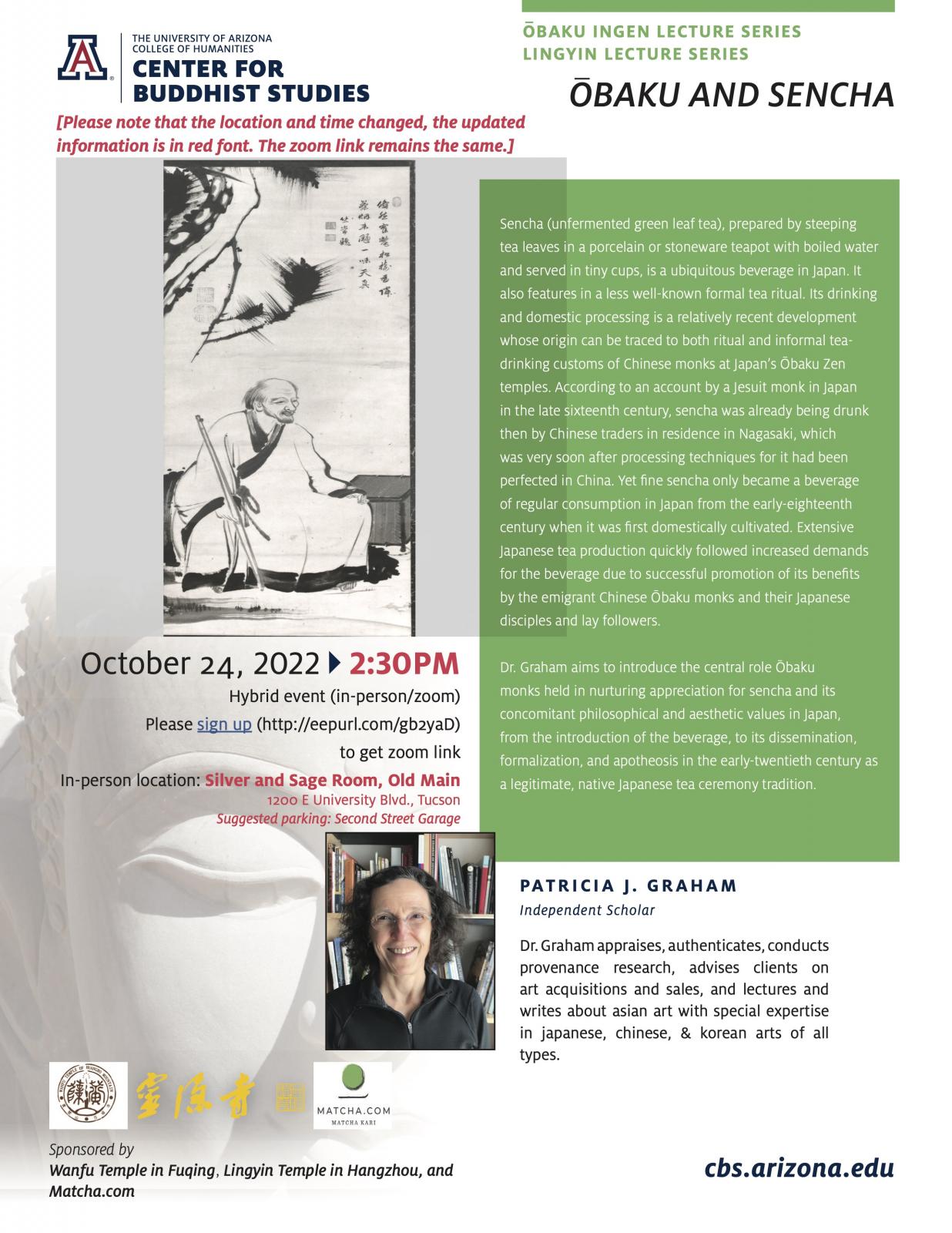
[IMPORTANT UPDATE: The in-person location and time of Dr. Graham’s lecture have been changed to 2:30 pm, Silver and Sage Room, Old Main. The zoom link remains the same. Please note that the updated information is in red font in the updated flyer.]
Dear Friends of the Center for Buddhist Studies,
Please join us on October 24th at 2:30 pm in Silver and Sage Room, Old Main for the next lecture of Ōbaku Ingen/Lingyin Lecture Series of the term! This is a hybrid event (in-person/zoom). To receive a link to the webinar, please sign up for our email list here: http://eepurl.com/gb2yaD. If you are already on our list of “Lectures and Academic Research,” you will receive the link soon.
Speaker: Dr. Patricia Graham (Independent Scholar)
Talk title: “Ōbaku and Sencha”
Time and Location:
Oct. 24 (Monday), 2022
Hybrid event (In-person/Zoom)
Time: 2:30-4:00 pm (Arizona Time)
Location: Silver and Sage Room, Old Main
Address: 1200 E University Blvd, Tucson
Speaker Bio:
Dr. Graham appraises, authenticates, conducts provenance research, advises clients on art acquisitions and sales, and lectures and writes about asian art with special expertise in japanese, chinese, & korean arts of all types. See her website for detailed information: http://www.patriciagraham.net
Abstract:
Sencha (unfermented green leaf tea), prepared by steeping tea leaves in a porcelain or stoneware teapot with boiled water and served in tiny cups, is a ubiquitous beverage in Japan. It also features in a less well-known formal tea ritual. Its drinking and domestic processing is a relatively recent development whose origin can be traced to both ritual and informal tea-drinking customs of Chinese monks at Japan’s Ōbaku Zen temples. According to an account by a Jesuit monk in Japan in the late sixteenth century, sencha was already being drunk then by Chinese traders in residence in Nagasaki, which was very soon after processing techniques for it had been perfected in China. Yet fine sencha only became a beverage of regular consumption in Japan from the early-eighteenth century when it was first domestically cultivated. Extensive Japanese tea production quickly followed increased demands for the beverage due to successful promotion of its benefits by the emigrant Chinese Ōbaku monks and their Japanese disciples and lay followers.
Dr. Graham has written extensively elsewhere about the development of the sencha tea ceremony, its role in facilitating the dissemination of Chinese cultural values to the broader populace, and the sociocultural mechanisms that facilitated its trajectory from a pastime of a small, elite group of Sinophile scholars into a formal tea ritual that is still practiced in Japan today. Here she aims to introduce the central role Ōbaku monks held in nurturing appreciation for sencha and its concomitant philosophical and aesthetic values in Japan, from the introduction of the beverage, to its dissemination, formalization, and apotheosis in the early-twentieth century as a legitimate, native Japanese tea ceremony tradition.
Please verify the time in your area via a time zone calculator as Arizona does not observe Daylight Savings Time.
Other time zones include:
2:30 PM (PDT) (Los Angeles)
5:30 PM (EDT) (New York)
10:30 PM (BST) (London)
5:30 AM (Tue. Oct. 25) (CST) (Beijing)
6:30 AM (Tue. Oct. 25) (JST) (Tokyo)
These lecture series are made possible thanks to the generous support from Wanfu Temple in Fuqing, Lingyin Temple in Hangzhou, and Matcha.com. For more information about our lecture series, please visit our website: https://cbs.arizona.edu/event/2022-fall-lecture-series
We look forward to seeing you there!


